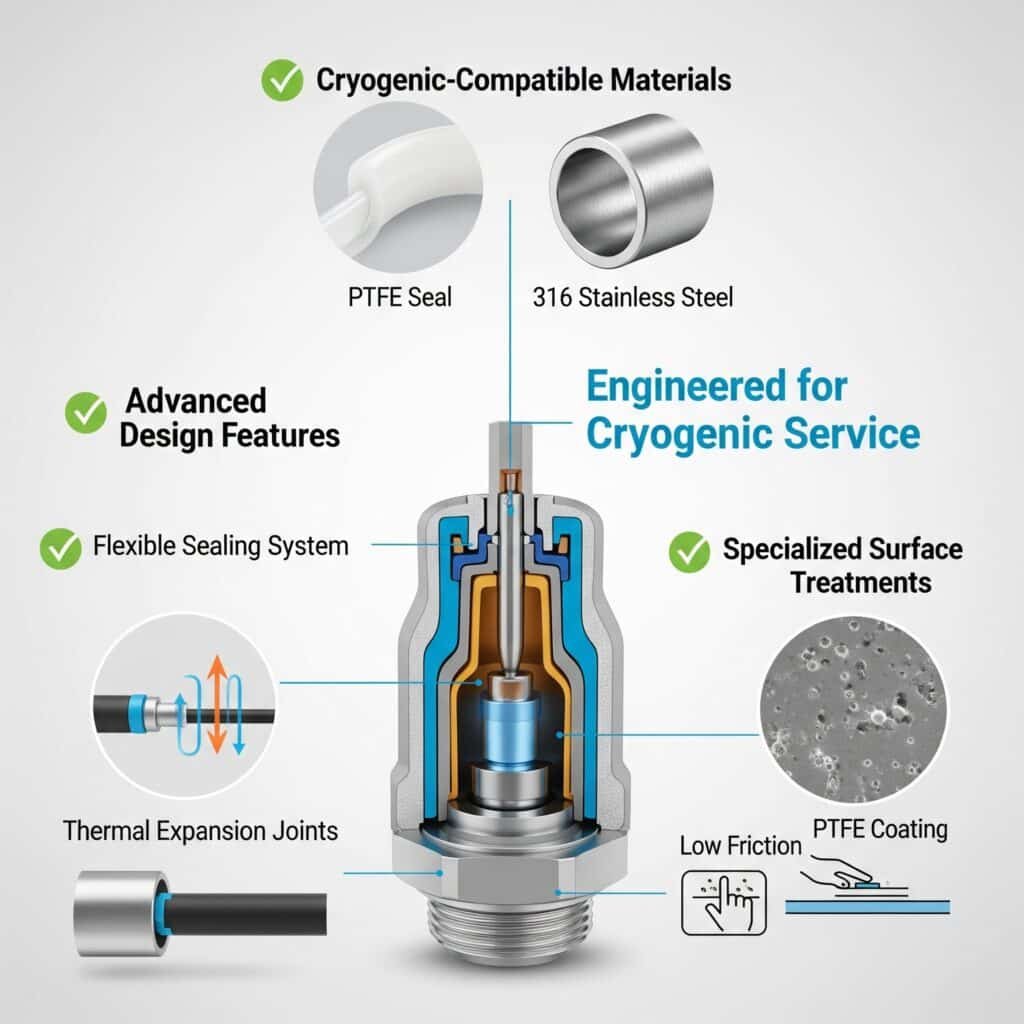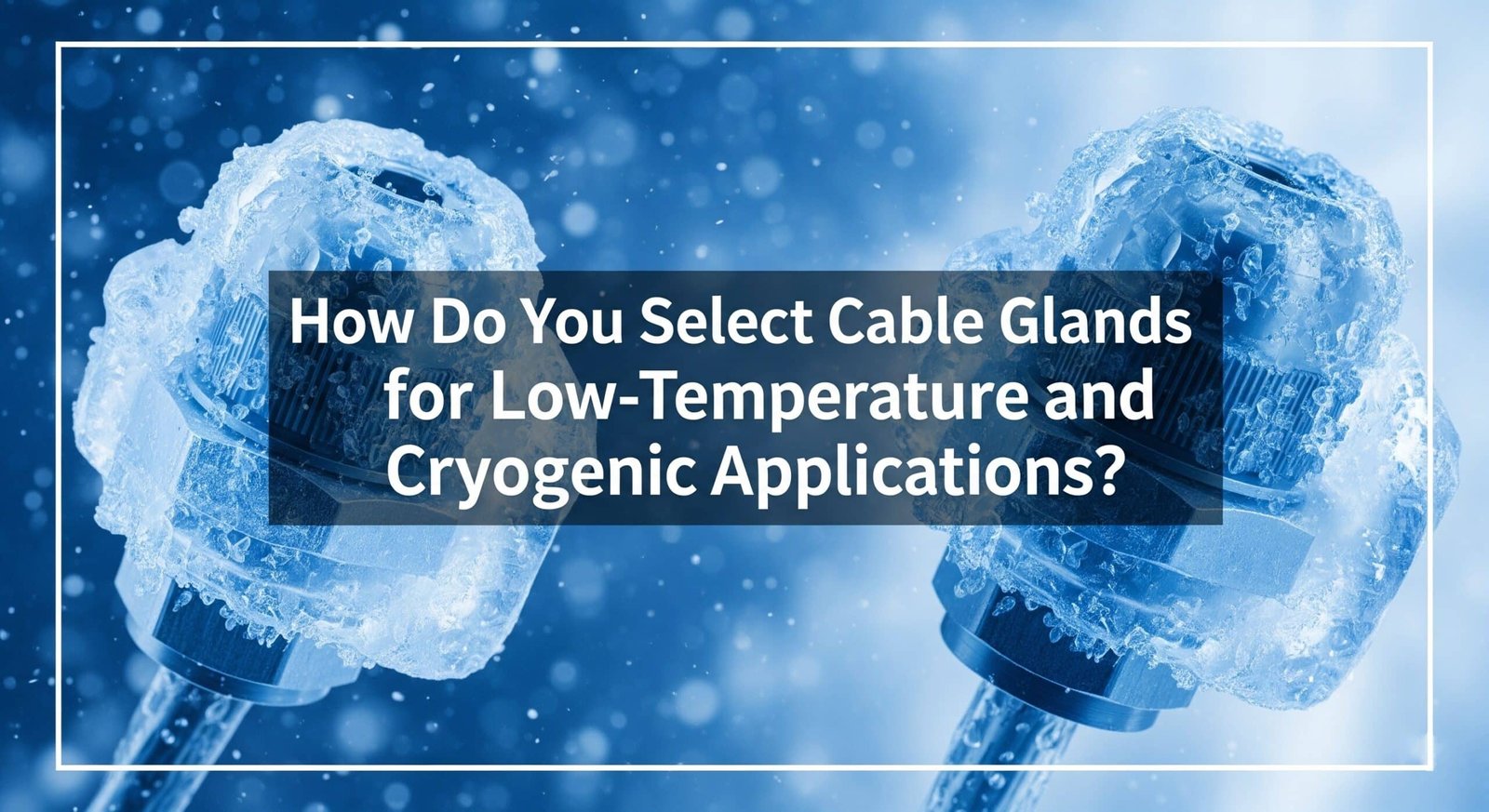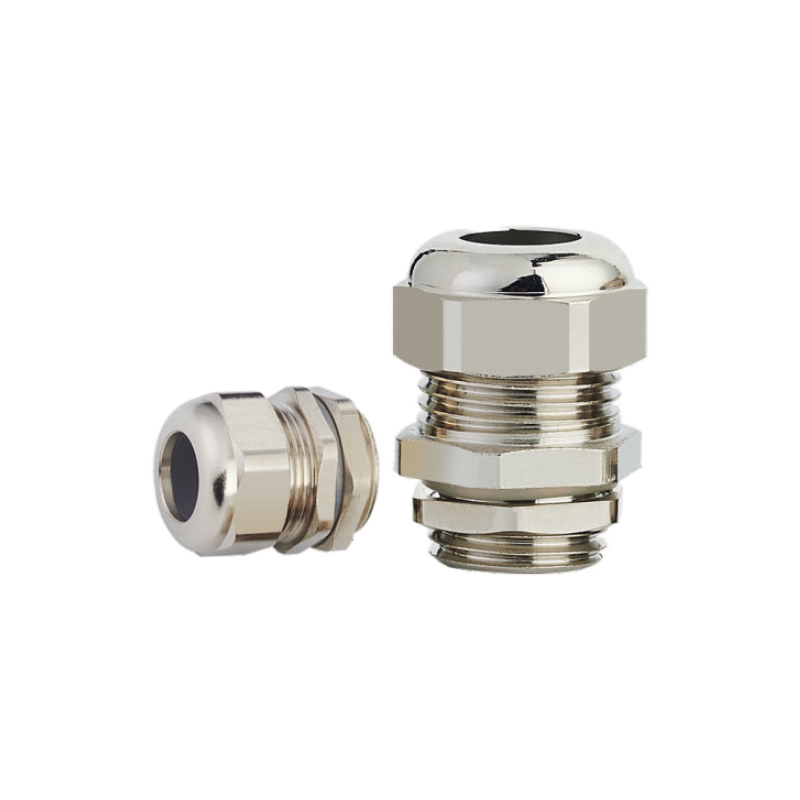Low-temperature and cryogenic applications1 expose cable glands to extreme thermal stress that causes standard elastomers to become brittle and crack, metal components to contract and lose sealing integrity, and conventional designs to fail catastrophically, leading to dangerous gas leaks, system failures, and costly shutdowns in critical facilities like LNG terminals and cryogenic storage systems. Traditional cable glands designed for ambient temperatures simply cannot withstand the thermal cycling and material challenges of cryogenic environments where temperatures can drop to -196°C or lower.
Az alacsony hőmérsékletű és kriogén alkalmazásokhoz használt kábeldugók speciális anyagokat igényelnek, beleértve a PTFE tömítéseket, a kriogén minőségű elasztomereket és a termikusan kompatibilis fémeket, valamint olyan kialakításokat, amelyek alkalmazkodnak a termikus összehúzódáshoz, fenntartják a tömítés integritását a szélsőséges hőmérsékleti tartományokban, és megbízható teljesítményt nyújtanak az igényes kriogén környezetben. These applications demand careful material selection, thermal expansion considerations, and specialized testing to ensure safe and reliable operation.
Having worked with engineers at LNG facilities in Qatar, cryogenic research laboratories in Germany, and industrial gas plants across North America, I’ve learned that selecting the right cable glands for extreme cold applications is critical for both safety and operational reliability. Let me share the essential knowledge for choosing cable glands that perform reliably in the most demanding low-temperature environments.
Tartalomjegyzék
- What Makes Low-Temperature Applications Challenging for Cable Glands?
- Which Materials and Design Features Are Essential for Cryogenic Service?
- How Do You Select Cable Glands for Different Cryogenic Applications?
- Mik a telepítési és karbantartási szempontok?
- How Do You Ensure Long-Term Reliability in Extreme Cold?
- FAQs About Low-Temperature Cable Glands
What Makes Low-Temperature Applications Challenging for Cable Glands?
Low-temperature applications challenge cable glands through material brittleness, thermal contraction, seal degradation, and thermal cycling effects that cause standard materials to fail, requiring specialized designs with cryogenic-compatible materials and thermal expansion accommodation to maintain sealing integrity and mechanical strength.
Understanding these challenges is crucial because standard cable glands can fail catastrophically in cryogenic service, creating safety hazards and operational disruptions.

Material Brittleness and Failure Modes
Elastomer Brittleness: Standard rubber seals become brittle and crack at low temperatures, losing their sealing capability and creating leak paths that can compromise system safety and performance.
Metal Embrittlement: Some metals become brittle at cryogenic temperatures, particularly carbon steels that can suffer impact failures or stress cracking under thermal cycling conditions.
Plastic Degradation: Standard nylon and other thermoplastics lose flexibility and impact resistance at low temperatures, making them unsuitable for cryogenic cable gland applications.
Adhesive Failures: Standard adhesives and sealants used in cable gland assembly can fail at low temperatures, causing component separation and seal integrity loss.
Thermal Contraction Effects
Differential Contraction: Different materials contract at different rates during cooling, creating stress concentrations and potential seal failures at material interfaces in cable gland assemblies.
Dimensional Changes: Significant dimensional changes during cooldown can affect thread engagement, seal compression, and overall cable gland integrity if not properly designed for thermal cycling.
Stresszkoncentráció: Thermal contraction creates internal stresses that can exceed material strength limits, particularly at design discontinuities and material transitions in cable gland construction.
Joint Loosening: Thermal cycling can cause threaded connections to loosen over time, requiring specialized thread locking compounds and design features for cryogenic service.
Thermal Cycling Challenges
Fatigue Effects: Repeated thermal cycling between ambient and cryogenic temperatures creates fatigue stresses that can lead to crack initiation and propagation in cable gland components.
Seal Degradation: Thermal cycling accelerates seal wear and degradation, particularly in dynamic applications where cables move during temperature changes.
Corrosion Acceleration: Condensation and thermal cycling can accelerate corrosion in metal components, particularly in the presence of moisture or aggressive environments.
Performance Drift: Material properties can change over multiple thermal cycles, affecting sealing performance and mechanical integrity over time.
Marcus, a process engineer at a major LNG terminal in Hammerfest, Norway, experienced the consequences of improper cable gland selection firsthand. During the facility’s first winter operation, several standard cable glands on critical instrumentation failed when temperatures dropped to -40°C, causing seal leaks and instrumentation failures that required emergency shutdowns. The standard EPDM seals had become brittle and cracked, while the brass bodies showed stress cracking from thermal cycling. We replaced them with specialized cryogenic cable glands featuring PTFE seals and stainless steel construction designed for -60°C service, eliminating the failure issues and ensuring reliable operation through multiple Arctic winters. 😊
Which Materials and Design Features Are Essential for Cryogenic Service?
Essential materials for cryogenic cable glands include PTFE and specialized elastomer seals, stainless steel or aluminum bodies, cryogenic-grade lubricants, and design features like flexible sealing systems, thermal expansion accommodation, and materials selected for low-temperature toughness and chemical compatibility.
Material selection is critical because standard materials simply cannot maintain their properties and performance at cryogenic temperatures.
Cryogenic-Compatible Sealing Materials
PTFE Seals: Polytetrafluoroethylene maintains flexibility and chemical resistance down to -200°C, making it ideal for primary sealing applications in cryogenic cable glands.
Specialized Elastomers: Advanced elastomer compounds including fluorocarbon and silicone formulations designed specifically for low-temperature service while maintaining sealing performance.
Viton® FKM: High-performance fluoroelastomers that maintain flexibility and chemical resistance at low temperatures, suitable for demanding cryogenic applications.
Kalrez® FFKM: Perfluoroelastomers offering the ultimate in chemical resistance and low-temperature performance for the most demanding cryogenic environments.

Metal Construction Materials
316 Stainless Steel: Austenitic stainless steel maintains toughness and corrosion resistance at cryogenic temperatures, making it ideal for cable gland bodies and hardware.
Alumínium ötvözetek: Certain aluminum alloys offer excellent low-temperature properties with reduced weight, suitable for applications where weight is a concern.
Inconel and Hastelloy: Superalloys for extreme service conditions combining cryogenic performance with superior corrosion resistance in aggressive environments.
Brass Limitations: Standard brass becomes brittle at low temperatures and is generally not recommended for cryogenic cable gland applications.
Design Features for Cryogenic Service
Flexible Sealing Systems: Multi-stage sealing designs that accommodate thermal movement while maintaining seal integrity throughout temperature cycling.
Thermal Expansion Joints: Design features that accommodate differential thermal expansion between components without compromising sealing or structural integrity.
Stresszoldó funkciók: Rounded corners, gradual transitions, and stress concentration reduction to prevent crack initiation during thermal cycling.
Moduláris felépítés: Designs that allow component replacement and maintenance without complete cable gland replacement, important for long-term serviceability.
Specialized Coatings and Treatments
| Treatment Type | Cél | Hőmérséklet tartomány | Alkalmazások |
|---|---|---|---|
| Electropolishing | Korrózióállóság | -196°C to +150°C | Food/pharma cryogenics |
| Passziválás | Surface protection | -200°C to +200°C | General cryogenic |
| PTFE Coating | Low friction/chemical resistance | -200°C és +260°C között | Extreme service |
| Cryogenic Lubricants | Thread protection | -196°C to +50°C | Assembly/maintenance |
Surface Treatments: Specialized surface treatments that enhance corrosion resistance and reduce friction at low temperatures while maintaining material properties.
Thread Compounds: Cryogenic-compatible thread sealants and anti-seize compounds that remain effective at low temperatures and prevent galling during assembly.
How Do You Select Cable Glands for Different Cryogenic Applications?
Cable gland selection for cryogenic applications requires analyzing operating temperature ranges, thermal cycling patterns, environmental conditions, and safety requirements to choose appropriate materials, designs, and certifications that ensure reliable performance in specific low-temperature environments.
Different cryogenic applications have unique requirements that affect material selection and design considerations.
LNG and Natural Gas Applications
Temperature Requirements: LNG applications typically operate at -162°C, requiring cable glands with proven performance at these temperatures plus safety margins for process upsets.
Biztonsági megfontolások: Natural gas environments require explosion-proof or gyújtószikramentes2 cable glands with appropriate hazardous area certifications for cryogenic service.
Termikus ciklikusság: LNG facilities experience frequent thermal cycling during loading/unloading operations, requiring cable glands designed for fatigue resistance and long-term durability.
Korrózióállóság: Marine environments at LNG terminals require superior corrosion resistance, typically stainless steel construction with appropriate surface treatments.
Industrial Gas and Air Separation
Liquid Nitrogen Service: -196°C operation requires the most demanding cryogenic cable glands with specialized materials and extensive low-temperature testing verification.
Oxygen Compatibility: Liquid oxygen applications require oxygen-clean cable glands with materials and lubricants that are oxygen-compatible and fire-resistant.
Process Purity: High-purity gas applications need cable glands with smooth surfaces, minimal outgassing, and materials that don’t contaminate the process streams.
Pressure Considerations: High-pressure cryogenic applications require enhanced mechanical strength and pressure ratings beyond standard cable gland designs.
Research and Laboratory Applications
Ultra-Low Temperatures: Research applications may require cable glands for liquid helium service at -269°C, demanding the most advanced cryogenic materials and designs.
Precíziós követelmények: Laboratory instruments require cable glands that maintain dimensional stability and don’t introduce measurement errors through thermal effects.
Tiszta környezet: Research facilities often require cable glands with low outgassing3 and particle generation characteristics for ultra-clean environments.
Flexibility Requirements: Research applications may need cable glands that accommodate frequent connections and disconnections without performance degradation.
Food and Pharmaceutical Cryogenics
Sanitary Design: Food processing applications require cable glands with smooth surfaces, crevice-free designs, and materials approved for food contact.
Cleaning Compatibility: Cable glands must withstand aggressive cleaning chemicals and high-pressure washdown procedures while maintaining cryogenic performance.
FDA-megfelelőség: Pharmaceutical applications require cable glands with FDA-approved materials and documentation for regulatory compliance.
Szennyeződés megelőzése: Sealed designs that prevent product contamination while maintaining performance through repeated thermal cycling.
Hassan, who manages a large industrial gas facility in Abu Dhabi, UAE, faced unique challenges when expanding their liquid nitrogen production capacity. The extreme temperature differential between the +50°C ambient temperature and -196°C process conditions created severe thermal cycling stress on cable glands serving critical control instrumentation. Standard cryogenic cable glands designed for moderate climates couldn’t handle the extreme thermal cycling. We provided specialized cable glands with enhanced thermal expansion accommodation and advanced PTFE sealing systems designed specifically for extreme thermal cycling conditions, enabling reliable operation in the challenging Middle Eastern climate.
Mik a telepítési és karbantartási szempontok?
Installation and maintenance of cryogenic cable glands require specialized procedures including proper material handling, thermal conditioning, specialized tools, and safety protocols to ensure reliable performance and prevent damage during installation and service in extreme temperature environments.
Proper installation and maintenance are critical because improper procedures can compromise cryogenic performance and create safety hazards.
Telepítés előtti előkészítés
Material Conditioning: Cryogenic cable glands may require thermal conditioning or stress relief before installation to optimize material properties and performance.
Eszközkövetelmények: Specialized tools that maintain functionality at low temperatures and don’t damage cryogenic materials during installation and maintenance procedures.
Safety Protocols: Comprehensive safety procedures for working with cryogenic systems, including proper PPE, ventilation, and emergency response procedures.
Dokumentáció felülvizsgálata: Thorough review of installation instructions, material certificates, and performance specifications before beginning installation work.
A telepítés legjobb gyakorlatai
Hőmérsékleti megfontolások: Installation procedures that account for thermal expansion and contraction during system cooldown and operation.
Nyomatéki specifikációk: Modified torque values that account for material property changes at low temperatures and thermal cycling effects.
Seal Installation: Proper seal installation techniques using cryogenic-compatible lubricants and avoiding damage to specialized sealing materials.
Rendszerintegráció: Coordination with overall system design to ensure proper support, thermal isolation, and accessibility for maintenance.
Maintenance and Inspection Programs
Thermal Cycling Monitoring: Tracking thermal cycles and their effects on cable gland performance to optimize maintenance schedules and predict replacement needs.
Szivárgásérzékelés: Specialized leak detection methods appropriate for cryogenic systems, including helium leak testing and thermal imaging techniques.
Material Inspection: Visual and non-destructive inspection methods to identify material degradation, cracking, or other damage from cryogenic service.
Teljesítménytesztelés: Periodic testing of sealing integrity, electrical continuity, and mechanical properties to ensure continued performance.
Vészhelyzeti reagálási eljárások
Hiba válasz: Procedures for responding to cable gland failures in cryogenic systems, including isolation, repair, and emergency replacement protocols.
Biztonsági megfontolások: Emergency procedures that account for the unique hazards of cryogenic systems, including asphyxiation, frostbite, and pressure hazards.
Pótalkatrész-kezelés: Maintaining appropriate spare parts inventory with proper storage conditions for cryogenic-grade materials and components.
Képzési követelmények: Specialized training for maintenance personnel working with cryogenic cable glands and systems.
How Do You Ensure Long-Term Reliability in Extreme Cold?
Long-term reliability in cryogenic applications requires comprehensive material testing, performance monitoring, preventive maintenance programs, and continuous improvement based on field experience to optimize cable gland selection and maintenance practices for specific operating conditions.
Reliability is critical in cryogenic applications because failures can create safety hazards and costly operational disruptions.
Anyagvizsgálat és validálás
Cryogenic Testing: Comprehensive testing programs that verify cable gland performance at operating temperatures plus appropriate safety margins for process variations.
Thermal Cycling Tests: Accelerated testing that simulates years of thermal cycling to predict long-term performance and identify potential failure modes.
Kompatibilitási tesztelés: Material compatibility testing with specific process fluids, cleaning chemicals, and environmental conditions encountered in service.
Minőségbiztosítás: Rigorous quality control programs that ensure consistent material properties and manufacturing quality for cryogenic service.
Performance Monitoring Systems
Állapotfigyelés: Continuous monitoring systems that track cable gland performance indicators including temperature, pressure, and leak detection.
Előrejelző karbantartás: Data analysis programs that predict maintenance needs based on operating conditions, thermal cycling history, and performance trends.
Hibaelemzés: Comprehensive analysis of any failures to identify root causes and implement corrective actions to prevent recurrence.
Teljesítmény-összehasonlítás: Tracking performance across different cable gland designs and applications to optimize selection criteria and specifications.
Continuous Improvement Programs
Field Experience Integration: Incorporating lessons learned from field installations to improve cable gland designs and application guidelines.
Technology Development: Ongoing development of new materials and designs to improve performance and reliability in cryogenic applications.
Standard Development: Participation in industry standards development to establish best practices for cryogenic cable gland applications.
Training and Education: Continuous training programs to ensure personnel understand the unique requirements of cryogenic cable gland applications.
Következtetés
Selecting cable glands for low-temperature and cryogenic applications requires understanding the unique challenges of extreme cold environments and choosing specialized materials and designs that maintain performance and safety. Success depends on proper material selection, appropriate design features, and comprehensive installation and maintenance procedures.
The extreme conditions in cryogenic applications demand the highest quality materials and most careful engineering to ensure safe and reliable operation. At Bepto, we understand the critical requirements of low-temperature applications and provide specialized cryogenic cable glands with proven materials and designs for the most demanding environments. Our engineering team works with facility operators to ensure proper selection and implementation of cable glands that deliver reliable performance in extreme cold conditions.
FAQs About Low-Temperature Cable Glands
Q: What temperature range do cryogenic cable glands handle?
A: Cryogenic cable glands typically handle temperatures from -196°C (liquid nitrogen) to +150°C, with specialized designs available for liquid helium service at -269°C. The exact range depends on materials and design specifications for your specific application.
Q: Can I use standard cable glands in low-temperature applications?
A: No, standard cable glands will fail in cryogenic service due to material brittleness and thermal contraction effects. You need specialized cryogenic cable glands with PTFE seals and appropriate metal construction designed for low-temperature service.
Q: How do I prevent thermal cycling damage in cryogenic cable glands?
A: Select cable glands designed for thermal cycling with flexible sealing systems, stress relief features, and materials that maintain properties through temperature changes. Proper installation and regular inspection are also essential for preventing thermal cycling damage.
Q: What materials work best for cryogenic cable gland seals?
A: PTFE provides the best overall performance for cryogenic sealing, maintaining flexibility and chemical resistance to -200°C. Specialized fluoroelastomers like Viton® and Kalrez® are also used for specific applications requiring elastomeric properties.
Q: Do cryogenic cable glands require special installation procedures?
A: Yes, cryogenic cable glands require specialized installation including proper torque specifications for low temperatures, cryogenic-compatible lubricants, and procedures that account for thermal expansion and contraction during system operation.



